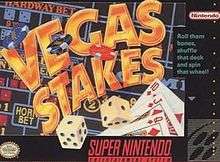Vegas Stakes
Vegas Stakes, known as Las Vegas Dream in Japan, is a gambling video game developed by HAL Laboratory and released in April 1993 for the Super Nintendo Entertainment System,[3][4] and for the Game Boy in December 1995.[5][6] The Super NES version supports the Super NES Mouse,[7] while the Game Boy version is compatible with the Super Game Boy, and features borders which use artwork from the SNES version. It is the sequel to the NES game Vegas Dream.
| Vegas Stakes | |
|---|---|
 North American box art | |
| Developer(s) | Dice HAL Laboratory |
| Publisher(s) | Nintendo Imagineer (SFC) |
| Composer(s) | Kimitaka Matsumae (SNES version only) Manami Matsumae |
| Platform(s) | Super NES, Game Boy |
| Release | Super NES Game Boy
|
| Genre(s) | Casino |
| Mode(s) | Single-player Multiplayer |
The game sees the player go to Las Vegas to gamble with $1000. Using that $1000, the player must try to win $10 million at different casinos.
Gameplay
In the SNES version, the player can choose to play either a single-player or multiplayer game. The multiplayer mode is not included in the Game Boy version. In the single-player game, a computerized friend accompanies the player around various casinos. In the multiplayer game, poker cannot be played since everyone could see everyone else's cards. At the beginning of the single-player game, a car is seen driving to Las Vegas. The various "friends" of the player are introduced as Cliff, Maria, Isabelle and Richard. All are eager to begin gambling. The "friends" are not present in the Game Boy version.
The player is given $1,000. The player's goal is to win $10 million.[8] If the player loses all the money, the game ends, and an image is shown of a man showing his empty pockets.
The game features blackjack, poker, craps, roulette, and slot machines.[6][9] When the player wins $100,000, the Laurel Palace casino is unlocked.[6][8] A total of five casinos are featured in the SNES version,[9] while four are featured in the Game Boy version.[6]
Aside from gambling, the player will also have interactions with the traveling party, and with random casino patrons. The player can make or lose money, depending on the response given to these patrons. In one example, a patron may attempt to pickpocket the player's character by pretending to wipe a spot off the character's shirt.[6][8][9] There are no random encounters in multiplayer mode. Several additional patron interaction situations exist in the Game Boy version.
At the end of the SNES version, the player gets to type in what they plan to do with their winnings. At the end of the game, a couple drive up to a casino with the player's name on it. Also at the end of the SNES version, the game tells the player what they typed in came true.
Reception
Nintendo Power praised the SNES version for its realistic gambling games, its four-player mode, and its compatibility with the Super NES Mouse. However, Nintendo Power negatively wrote, "More variety in the games would have been nice."[3]
Nintendo Power praised the Game Boy version for "Easy controls" and a "Fun adventure element," but criticized it for featuring, "Only four games of chance." GamePro's brief review of the Game Boy version commented, "Vegas Stakes is fun and offers a variety of games, including Craps, Roulette, Blackjack, Poker, and Slots. The graphics are crisp and clear, and the cheesy music fits in nicely."[10]
Scott Alan Marriott of AllGame rated the SNES version four stars out of five and wrote, "Vegas Stakes is an excellent example of how to do a casino game on the console format. Instead of merely aiming for the gambling crowd, the developers included several surrounding characters to inject some life into the game." However, Marriott also wrote, "The graphics aren't anything to shout about -- most screens are digitized still pictures. Cards might be hard for some players to read as they are a bit on the small side." Marriott also criticized the game's music and sound: "While each casino has its own theme song, it repeats endlessly and there's no way to turn it off. Make sure you have your thumb close to the remote control's mute button! Some voice clips would have been appreciated..."[8]
References
- "Release information". MobyGames. Retrieved 2014-07-13.
- "Super NES release date". 2009-04-19.
- "Vegas Stakes (SNES)". Nintendo Power. Nintendo of America. April 1993. pp. 103–104. Retrieved 2016-06-01.
- Marriott, Scott Alan. "Vegas Stakes - Overview (SNES)". AllGame. Archived from the original on 2014-11-14. Retrieved 2016-06-01.
- Marriott, Scott Alan. "Vegas Stakes - Overview (Game Boy)". AllGame. Archived from the original on 2014-11-14. Retrieved 2016-06-01.
- "Vegas Stakes". Nintendo Power. December 1995. pp. 90–93, 105. Retrieved 2016-06-01.
- "Let's Get Technical". GamePro. No. 76. IDG. January 1995. p. 14.
- Marriott, Scott Alan. "Vegas Stakes (SNES) Review". AllGame. Archived from the original on 2014-11-14.
- "Super Casino Games: Vegas Stakes". Nintendo Power. Nintendo of America. June 1993. pp. 20–22. Retrieved 2016-06-01.
- "ProReview: Vegas Stakes". GamePro. No. 90. IDG. March 1996. p. 69.
External links
- Virtual Console web page (North American)
- Vegas Stakes at MobyGames